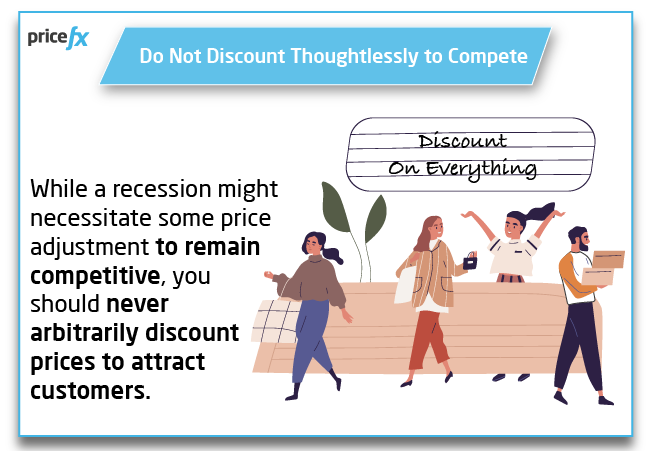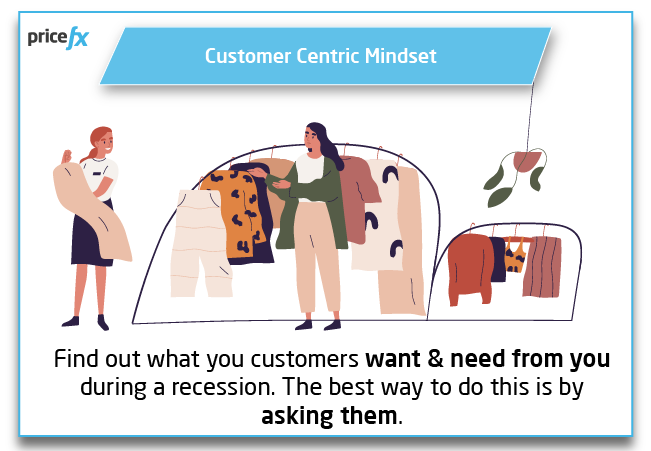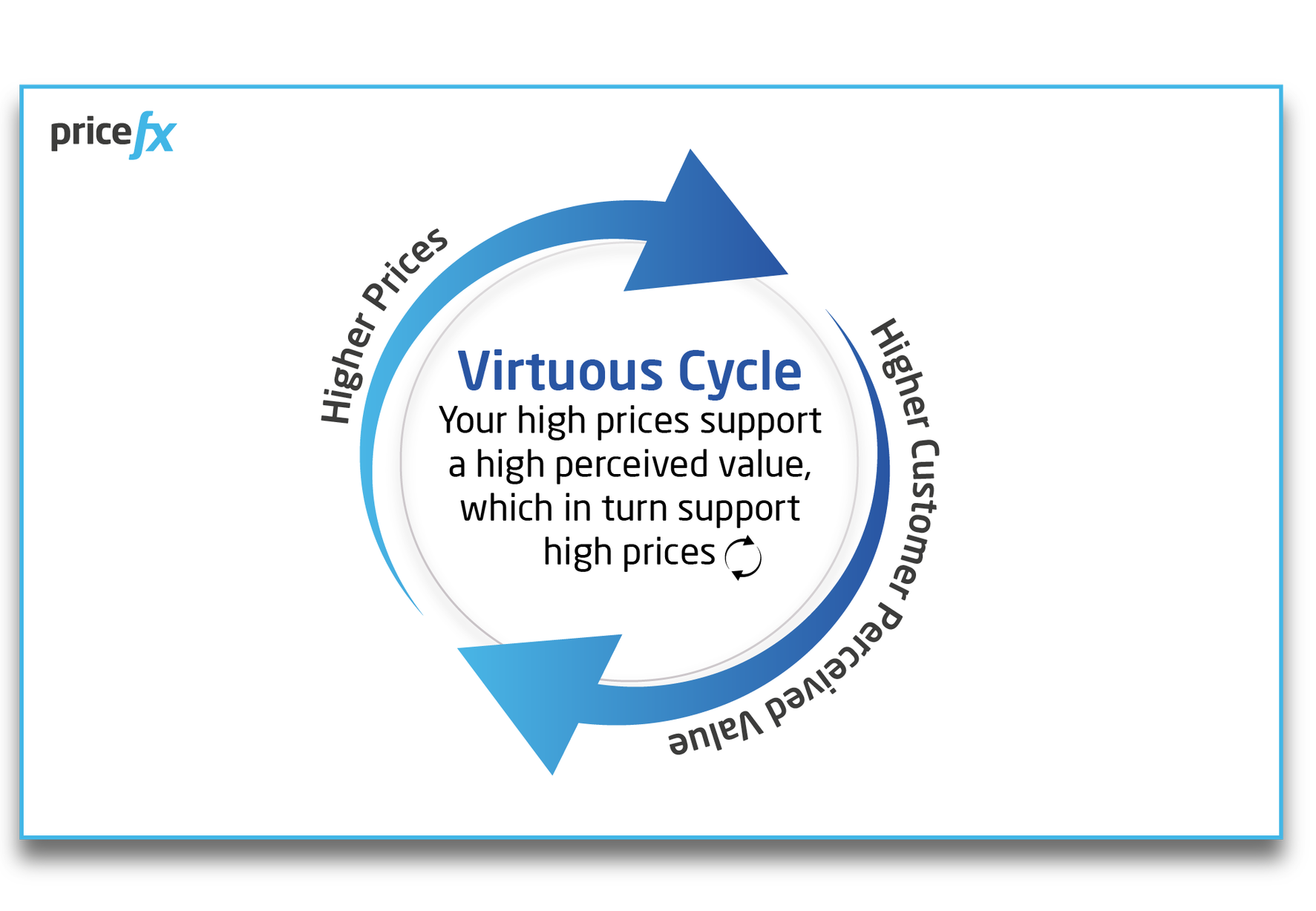Recession Pricing: 3 Do’s & Don’ts for Your Business
January 30th, 2023 (Updated 03/09/2023) | 11 min. read
By Ken Edwards
The current economic outlook is not great. The word “recession” is all over the business news, and, at the time of writing, it feels like we are in a kind of stasis of “will it be a recession or won’t it”? Opinion appears to be split between those who believe a recession is unavoidable, business leaders who believe that we can sidestep the doom and gloom, and finally those ‘fence sitters’ who feel that the outcome could still fall on either side of the fence. Understanding that no one knows for sure what could happen and in a constantly changing marketplace business leaders cannot pinpoint precisely if the economy will turn sour and when, the best option is to be prepared. That is exactly why we have prepared this article on ‘Recession Pricing: 3 Do’s and Don’ts for Your Business’.
At Pricefx, as a provider of modern pricing software, we have spent more than a decade answering all manner of pressure points from our customers including assisting them in managing through tough economic times of sudden and extreme change.
So, let’s dive right on in by looking at 3 dos and don’ts that your business can look at when considering recessionary and inflationary pressures and what your organization can do to keep the persistent price fluctuations under control in the face of rough economic times.
The 3 Must-Dos to Get Your Business Recession-Ready
Pricing during an economic downturn or recession is a tricky business. Too often, companies simply cut prices to attract more sales. The right pricing, however, can help a company compete and even thrive during complicated economic times. Here are three of the pricing dos for a recession:
1. Diversify With an Eye to Innovation & Flexibility
In the current economic state, it has never been more important to think long term and make smart decisions. It can be easy to get caught up in the ‘right now’ moment and make decisions you may later regret like devaluing your products too much just to win the sale.
When you are making business decisions, keep an eye on the future. You may have to change course on the fly and think quickly.
Study what your competitors are doing. Competition can be fierce during a recession as every business wants their share of shrinking spending. However, just because someone else is taking one course of action, that doesn’t necessarily mean it’s right for you and your business. Research before jumping into any new pricing strategies.
Find out what your customers want and need from you during a recession. The best way to do this is by asking them. It may surprise you how much your customers will pay for a product or service that can help them survive during a severe economic slowdown.
Consider if there are populations of customers you are not currently targeting. Think about how customers access your products. Add delivery, business-to-business sales, bulk pick-up or even subscription services.
Your business may also be able to diversify its offerings by adding new price points to your product portfolio. For example, if your business usually makes sweaters from high-end Merino or alpaca wool, you might want to consider adding a lower entry level line from a cheaper synthetic version of the same stylish sweaters to catch customer with tighter budgets but love your designs.
Or if your business makes chic leather jackets, consider offering a similar line in faux leather that are more affordable, and may even open your line to a new range of buyers you may not have considered before, like vegan shoppers.
During a recession, realize that you must remain open to adapting to a changing market. A recession doesn’t have to mean panic — keep focused, flexible and financially aware. Take it as an opportunity to get to know your company better and become more creative with your offerings.
2. Focus on Value Pricing
Inevitably when the sales begin to dry up as the economy contracts in a recession, the natural reaction of many businesses is to say “Okay, I’ll do whatever it takes to get some business in the door.” And usually, those businesses are referring to discounting and dropping prices.
Cutting prices is a time-tested method of dealing with recessions. Consumers tighten belts in a recession and can decide on delaying purchases for prolonged periods, search for cheaper products, or even change their purchasing strategies over the medium-to-long term. Price cutting may keep customers who are looking for less expensive products and maintain the loyalty of those who may otherwise put off purchases.
But it can be a big mistake to devalue your company’s offerings.
Your number one priority should be focusing on the value of the product or service, rather than the price.
With value pricing, you get paid the exact amount you deserve to be paid, an amount designated for profitability.
Getting into a price war with your competitors – without remembering that your company’s products or services are unique and have their own intrinsic value both for your business and your customers – can send you and your competition swirling into a downward pricing death spiral where no one wins.
What’s more, decreasing prices as a business strategy can backfire, too, by eroding profitability. If your profits drop, it can affect not only your bottom line but negatively affect your organization’s valued position in your industry sector.
One of the best ways to navigate a recession and stand out from your competitors is to focus on communicating the intrinsic value of your products and services.
Through effective marketing, you can remind your clientele of your unwavering commitment to high-quality service and customer satisfaction regardless of the economic landscape.
3. Make Data-Driven Decisions
Ensure that the data you need is available at your fingertips to avoid making hasty decisions.
Possibly the very worst thing you can do for your company’s pricing during a recession is failing to act, but on the other hand, it is also easy to glaze over with analytical paralysis in the shifting fog of an economic climate in recession. Whatever your business chooses to do, continue making decisions. However, ensure you are making well-informed, data-driven decisions so you’re not just acting on gut. Of course, using a next-gen pricing software system to help you define and quantify the pricing actions that your company makes is critical.
Use the analytics component of your pricing software to identify your highest priorities and make the smartest decisions you can. Don’t waste time punishing mistakes when they occur. Continue moving forward in a better and more profitable direction as soon as possible.
Many companies choose to double down on their recession price cuts with sweeteners, such as free shipping, extended payment terms, or complimentary customer support. Despite being “free” or reduced, these, in fact, do cost your company some cash. The result is known as price leakage, or margin leakage.
Don’t let these and similar programs erode profits. They can be just as damaging as indiscriminate price cuts if not monitored and controlled. Use your data and pricing software (which frequently has rebate management or allowance and promotions management as part of the package) to track where the gaps occur and plug your profit leaks.
3 Pricing Don’ts to Avoid in a Recession
Just the word “recession” itself can automatically trigger the fear response in the most experienced of pricing managers or CEOs. However, taking the opportunity to move from fear to action can help most businesses ride out economic uncertainty. But don’t let that action become a wild panic. Uncertain economic times call for a cool head and taking the time to draw breath and avoid rash decision-making. With that in mind, consider these 3 pricing ‘don’ts’ to avoid during a recession.
1. Don’t Discount Thoughtlessly to Compete
While a recession might necessitate some price adjustment to remain competitive, you should never arbitrarily discount prices to attract customers. Alternatively, consider exploring new pricing models, packaging and bundling products and services, and creative contract writing to maintain revenue while continuing to attract new clientele.

Discounting is a time-tested method of dealing with recessions. Often, your prospects tighten their spending in a recession and may not purchase for extended periods, search for cheaper products, or can even change their long-term acquisition strategies. At its best, price cutting may help to retain customers who are looking for less expensive products while simultaneously maintaining the loyalty of customers that otherwise may begin to look elsewhere for cheaper deals.
However, price cutting as a strategy can backfire by eroding profitability.
If your profits drop, it can affect not only your company’s bottom line but your market position too.
For example, will the loss of profit affect your Research and Development (R&D) budget? If your organization is innovation reliant, will the negative impact on your R&D run a risk of you falling behind your competitors in new product development?
Discounting can potentially do more to whittle away your profits than any other factor. Offering a discount is not always the answer, and in the long term can do more harm to your business than good.
2. Don’t Waste Time & Energy Pursuing All Sales Leads
Make the most of your precious resources and don’t waste them by pursuing every single sales lead that crosses your path. Stick to a clear and defined process for qualifying or disqualifying prospects so that your sales team only spends their time on the right leads for you that align with your most ideal client profile.
Try to filter out the timewasters by producing educational content on your website and social media that helps prospects disqualify themselves so that your sales team do not have to waste their time on inappropriate leads.
When price-driven prospects threaten to take their business elsewhere, consider either:
(1) Unashamedly pointing out the unique value your products and services offer, justifying your value pricing or….
(2) Graciously allow businesses that are attempting to beat you down on price and continually badgering your salespeople for discounts, to head instead to your competitors.
Take the recession as an opportunity to re-evaluate your sales approach to improve the process and/or adapt to more targeted and meaningful discussions with your prospects as they also navigate the crisis.
3. Don’t Guess or Use ‘Gut-Feel’ to Price
To say that some companies use a wild guess to price their products or services is a slight exaggeration. Most businesses will have some intuitive sense of what their prices should be by comparing their prices to those of other products or services offered by those in the same industry sector. They set their prices based on their own purchasing experience and on the value they see in their offerings. Guessing prices is some form of ‘educated’ guess, but it is still a guess. Kiss those guessing processes goodbye.
Even if your organization guesses prices “close enough” to stay in business, those prices could be “wrong enough” to forever struggle for profitability in a competitive market. Maybe you are even getting to “close to correct” in your pricing, but that means you are still leaving money on the table or missing out on the maximum sales volume that you could potentially achieve.
Companies using data-driven technology know there are better ways to set their prices.
Tapping into the voices of customer data can provide valuable insights.
Predictive consumer data allows retailers or brands to select the winning concepts and eliminate under-performing products.
Too many factors are in play even in the best economic conditions to rely on old pricing strategies.
Modern pricing software tools armed with price optimization allow for businesses to test different price points in real time, determine ideal prices, eliminate product features that add no value, and maximize profit.
Data-driven pricing strategies can empower organizations to stay one step ahead of their price-conscious consumers while protecting margins and bottom-line results in challenging economic times.
Get Proactive in Your Recession-Proofing Your Business

Now you know 3 pricing dos and don’ts that can help you maintain your organization’s profitability during a recession.
If you are looking to do more for your company in a recession rather than merely ride out the storm, then you will want to adopt a comprehensive and award-winning pricing software solution like Pricefx that can assist you by responding in real time. The possibility of losing margin, slow price list updates and leaving money on the table at a time when you need it most is a real and constant threat in tough economic times.
If your company is done with losing out when you don’t have to, then it sounds like it’s time for your business to start exploring your pricing software options.
If you already know that a total pricing solution will fit your company’s needs, this article below can help you finalize your pricing software choice:
On the other hand, if you have already exhausted your search for the best pricing software for your company and have decided on Pricefx, talk to one of our pricing experts today to get started on better pricing:






